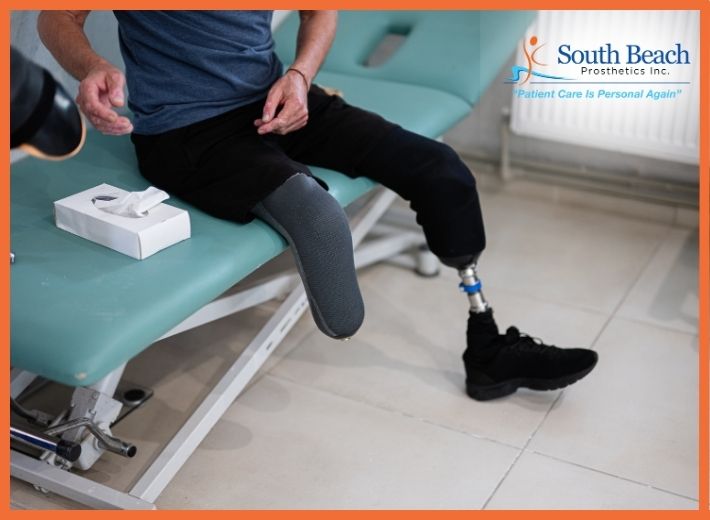We want to be sure you understand the process you will go through to get your prosthesis.
The following information is designed to assist our patients – you – in understanding the process you will go through to get your prosthesis. Every patient has their own set of circumstances and every situation is different. The length of time it takes to start the process after your amputation depends a lot on the length of time it takes your residual limb and incision site to heal.
Our team will guide you through this transition every step of the way. Our peer visitors will consult with you before and after your procedure, and our expertly trained practitioners will ensure your experience is a pleasant one throughout the entire process. Your doctor will decide when you are sufficiently healed and ready to begin the process. The examinations and meetings are generally weekly, though may be more or less frequent depending on your specific situation.peer visitors will consult with you before, and after your procedure

First Visit – Evaluation and Casting
On your first visit, we will gather clinical and personal background information from you. This includes information about your general physical health, your lifestyle, as well as your personal and medical history. We will consult and discuss the prosthetic options available to you based on our professional assessment of your lifestyle, strength, activity level, and goals.
Prior to casting, we also examine your residual limb for any prominent bones, sensitive areas, and swelling. It is extremely important that your leg not be swollen when we take a cast of your leg to make the socket. If you are swollen, we have a variety of methods to help comfortably reduce the swelling and get you ready for a casting.
Some insurance companies require prior authorization before starting the procedure to make your prosthesis. If this is the case, we will do only the evaluation at this appointment. Once we get authorization, we will contact you to make an appointment for your casting in conjunction with your insurance company’s cooperation.
Once your leg is at a consistent volume and we have verified your insurance coverage, we will take measurements and a cast of your residual limb. We will also take measurements of your sound leg to ensure the height of the prosthesis is accurate.
Second Visit – Initial Fitting and Alignment
During the second visit, you will be fit with a clear plastic socket that was made from the earlier cast of your residual limb. This is called a “check socket” — it is used to check the fit of the prosthesis on your residual limb. During this appointment, we will need the shoes you will be wearing most often with your prosthesis. You will walk between the parallel bars while wearing the check socket. At this time, we will check for correct height and also change the alignment of the prosthesis. Changing the alignment means that we make changes which will improve your gait – how you walk – and give you the greatest stability and comfort.
Depending on the situations encountered during this appointment, you may possibly need another “check socket” made, which will mean an additional visit and a repeat of this visit.
Third Visit – Fitting and Delivery
During this appointment, you will be fit with your new custom prosthesis along with a supply of prosthetic socks. Our practitioner will educate you on the proper donning of your prosthesis, and how to determine the correct number of prosthetic socks to wear. If this is your first prosthesis, do not expect to wear it all the time in the beginning – we recommend a short period of time the first day and gradually increase the wearing time each day.
Ongoing – Observation & Follow-Up
During the early use of the prosthetic, you should check the skin on your residual limb often for signs of irritation or redness. Redness over a large area that dissipates after removal of the prosthesis is usually normal. If you have very localized redness inside the larger reddened area caused by pressure, please contact your practitioner as soon as possible for an appointment so that the correct changes can be made.
We also recommend that first-time prosthetic wearers receive physical therapy. A physical therapist will “teach” you how to walk and do other daily activities while wearing your prosthesis.
Your practitioner will schedule a follow-up appointment for 1-2 weeks after you receive your prosthesis. At this time, we will address any concerns or problems you may be having. If you begin to experience discomfort before this appointment, call our office to schedule an earlier appointment.
If you begin to experience discomfort, remember that your prosthesis has not changed. It is more likely that your residual limb has undergone a physical change. Your prosthesis was designed to fit your residual limb’s unique shape. If your limb is not in the socket properly or if the shape of your residual limb has changed, it can be uncomfortable. Often this discomfort can be relieved by adding or removing prosthetic socks, but we strongly recommend calling your practitioner to discuss the issue and determine the next step.
PROSTHETICS
Our superior technology not only ensures exact measurements and shape for your prosthetic, but also a perfect match for your way of life. We perform an extensive evaluation of your body, health, and daily life, and use custom materials to build a prosthetic ideally suited to you.




